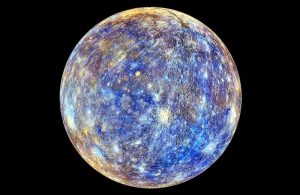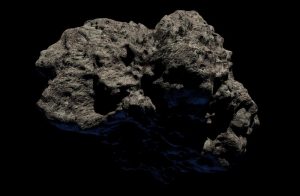Mercury
Mercury is the planet closest to the sun. As such, it revolves around the sun faster than all other planets, which is why the Romans baptized it with the name of god the swift messenger. The Sumerians also knew the planet Mercury for at least 5,000 years and was commonly associated with Nabu, the god of writing. The planet Mercury was also given different names because of its appearance as both a morning star and an afternoon star.

- Distance to the sun: 57.91 million kilometers
- Gravity: 3,7 m/s²
- Duration of the day: 58 days 15 hours and 30 minutes
- Orbital period: 115.88 days
What is Mercury?
Mercury is one of the planets of the solar system that is located at the closest position to the Sun and is also the smallest of all the 8 large planets that exist, which is about 58 million kilometers from the Sun.
Characteristics of Mercury
- It has a diameter of 4879.4 km.
- Its mass is 3.3010 x 1023 kg.
- The volume of the planet is 60,827,208,742 km3 and its density: 5.427 g/cm3.
- Its orbit is quite inclined and elliptical.
- It is a planet that can be seen from Earth without using telescopes.
- Its surface is surrounded by craters and it is possible to find ice on it.
- Its temperatures are extreme because the atmospheric layer it possesses is very thin, during the day, it can reach temperatures between 427 and 430° C and during the night, -173°C.
- Life is unlikely to exist on this planet.
History
The planet was called by its name by the Romans because for them, the planet was a gods messenger because it seemed to move faster than any other planet. Historians also mention that its name comes from the Roman god with the same name that also alluded to speed and agility. According to scientists, it was formed from a series of volcanic eruptions that deformed its crust and the planet’s surface, creating bright rings around each crater.
Composition
Mercury consists of approximately 70% metals and 30% silicate. In fact, it is only slightly less dense than the Earth, has many heavy elements inside and the core is considered to be large iron formed. Its atmosphere is composed of helium, sodium, oxygen and nitrogen. Its magnetic field is 1% and its source is unknown.
Atmosphere of Mercury
The atmosphere of Mercury is extremely thin and is composed of atoms that have been detached from its surface by solar wind, which consists of particles coming from the outermost layer of the sun. Sodium, potassium and mercury have been detected in the atmosphere, but these elements can be lost when they react with Sun’s and Mercury’s magnetic fields.
Magnetic field
Its magnetic field is very similar to that of the earth, but it is weaker, and began shortly after the planet formed more than 4500 million years ago. According to studies, it had a global magnetic field generated by liquid iron at very high temperatures within the planet’s core. It is the only planet in the inner solar system that has a magnetic field. Some studies affirm that the solar wind is responsible for the planet’s magnetic field constantly weakening.
Rotation
Mercury’s rotation is a bit complex to understand, it rotates on its axis very slowly compared to its orbital period. To complete a rotation the planet needs a total of 175.97 Earth time days, according to NASA, while an orbital period only takes 88 Earth time days. The day is 1,999 times longer than a single year. The equatorial rotation speed of the planet is 10,892 km/h.
Mercury translation
The translation movement lasts 88 days and is one of the most complicated, according to scientists, because some of their rotations have movements that very few planets are able to perform. It has not yet been possible to know its average rotation as it moves nor how its position in space affects the movements of translation as it rotates slowly.
Satellites
It is a planet that does not have natural satellites because it does not enjoy the presence of the moon.
Temperature
The temperature of the planet varies strongly between day and night due to its rotation and translation movements. At night its temperatures are extremely hot, around 350° and 450° C, and at night they can drop to -170°C.
Curiosities
Some curiosities we can tell you about Mercury are the following:
- It is the smallest planet in the solar system with only 4879 kilometers.
- It is the second densest planet in the solar system, after the earth.
- It is the second warmest planet in the universe and the closest to the sun, this happens because the face of Mercury is facing the sun.
- It does not have an atmosphere suitable for regulating temperatures.
- Its nucleus is melted according to the scientists, because it is full of Sulphur which does not allow it to be kept in a compact form.
- The geological movements and the contraction of the nucleus of the planet make it full of wrinkles.
How to cite this article?
Briceño V., Gabriela. (2019). Mercury. Recovered on 24 February, 2024, de Euston96: https://www.euston96.com/en/mercury/









